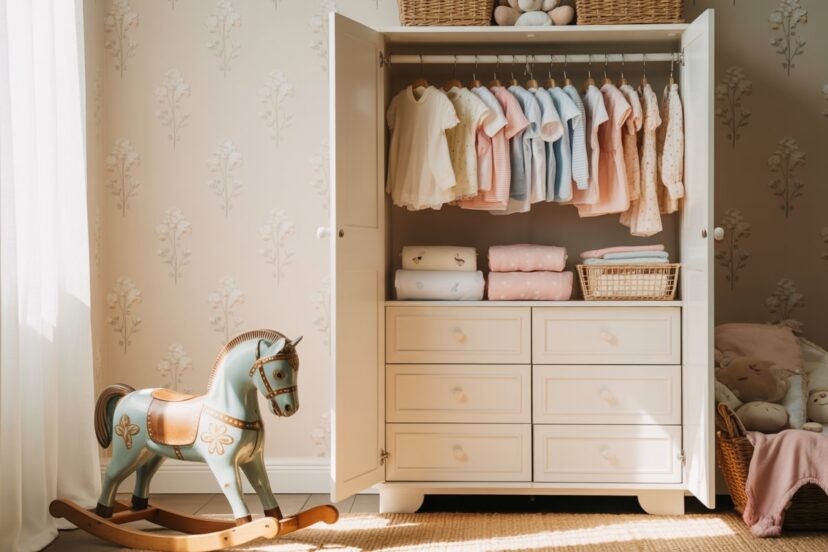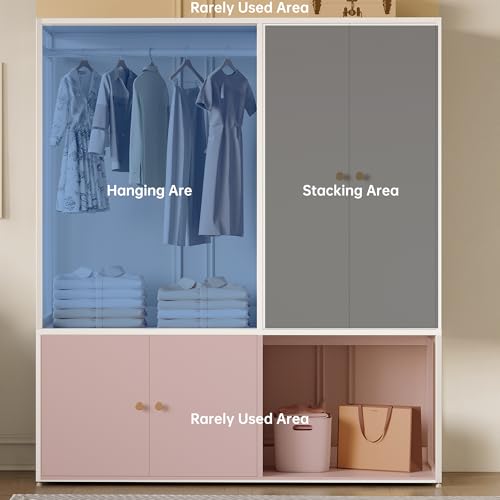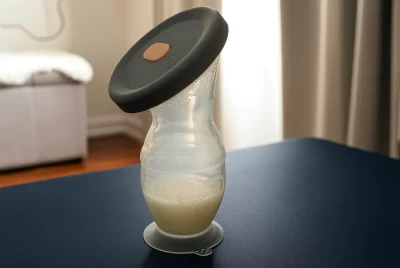Building the Perfect Baby Wardrobe
*We may earn a commission for purchases made using our links. Please see our disclosure to learn more.
There’s something undeniably magical about preparing a nursery and, more importantly, filling a dresser with tiny, perfect clothes for a new arrival. Yet this seemingly simple task can feel overwhelming. Parents often find themselves standing in stores or scrolling through endless online catalogs, asking themselves: “Do I really need all of this?” The truth is that building a functional, beautiful baby wardrobe doesn’t require an excessive amount of clothing or a bloated budget. It requires thoughtful choices, an understanding of what actually works, and the wisdom to distinguish between needs and wants.
The baby wardrobe journey is deeply personal. It reflects not just the climate and lifestyle of the family, but also their values around consumption, sustainability, and style. For many caregivers, the process of selecting clothes for their baby becomes a form of love—a tangible way to prepare for and welcome a new person into the world. This guide explores how to build a baby wardrobe that is practical, affordable, and genuinely useful from those first newborn days through the toddler years.
“Babies are not our only concern. The condition of their clothing reflects our values as caregivers.”
— Expert in child development and family wellness
Key Takeaways
- Quality matters more than quantity: A smaller collection of well-made, versatile pieces beats a closet full of cheap, poorly-fitting clothes.
- Essentials differ by climate: Warm-climate babies need lighter fabrics and fewer layers, while cold-climate babies require more layering pieces.
- Babies grow rapidly: Strategic sizing and growth room in clothing help maximize value and reduce waste.
- Multi-functional pieces are your best friend: Clothes that work across seasons and situations make dressing easier and more budget-friendly.
- Comfort and practicality trump trends: Easy-access features like snap closures and stretchy materials make diaper changes and dressing faster.
Recommended Baby Wardrobe
Sauder Select Multipurpose Baby Wardrobe Closet
Keep your nursery neat and organized with the Sauder Select Multipurpose Baby Wardrobe Closet in a charming Soft White finish. This versatile baby wardrobe is designed to provide ample storage for all your little one’s essentials—from tiny clothes and blankets to diapers and toys. It features a sturdy garment rod for hanging outfits and adjustable shelves that adapt as your baby grows, making it a long-term storage solution for your child’s room. The smooth-glide drawers offer easy access to everyday items, while the elegant white design complements any nursery or bedroom décor. Built from durable engineered wood and metal hardware, this baby wardrobe blends functionality, safety, and timeless style.
When it comes to organizing your baby’s room, the Sauder Select Multipurpose Baby Wardrobe Closet stands out as a stylish and practical choice. Its soft white finish brings a clean, calming look to any nursery while offering smart functionality that grows with your child. The built-in garment rod is perfect for hanging tiny outfits, while the adjustable shelves can hold everything from folded clothes to baby essentials. Two spacious drawers add extra storage for blankets, diapers, or toys, helping you maintain a clutter-free environment.
- Versatile Storage: Perfect for baby clothes, diapers, and toys with both hanging and shelving options.
- Elegant Design: The soft white finish suits modern nurseries and children’s bedrooms.
- Durable Build: Engineered wood and metal construction ensure stability and longevity.
- Assembly Required: May take time to put together without professional help.
- Large Size: Might not fit well in smaller nurseries or apartments.
- Limited Color Options: Only available in select finishes like Soft White and Reclaimed Pine.
LIKIMIO Large Baby Wardrobe Closet
Bring smart organization and elegant simplicity to your nursery with the LIKIMIO Large Baby Wardrobe Closet in classic white. This spacious baby wardrobe combines functionality and modern design to keep all your baby’s essentials neatly stored and easy to access. It features a hanging rod for baby clothes, five roomy shelves for folded garments or toys, and magnet-closed doors that open smoothly and quietly—perfect for a peaceful nursery.
For parents looking to combine practicality and modern design, the LIKIMIO Baby Wardrobe Closet offers the perfect solution. Its generous interior space features five shelves and a hanging rod, giving you flexible storage for your baby’s clothing, toys, and essentials. The thoughtful design includes magnet-closed doors and quiet metal hinges, ensuring you can access items without disturbing your little one’s sleep.
- Ample Storage Space: Multiple shelves and a hanging rod provide room for baby clothes, diapers, and accessories.
- Safety Focused: Includes anti-tip hardware and silent hinges to protect little ones.
- Stylish Design: Sleek white finish blends beautifully with modern nursery or home décor.
- Assembly Required: Setup may take time, especially without assistance.
- Heavy Build: At 123 pounds, it can be difficult to move once assembled.
- Limited Color Choices: Only available in white finish at this time.
COSVALVE Kids Dress Up Storage Wardrobe in Lovely Pink
Add a touch of charm and organization to your child’s playroom with the COSVALVE Kids Dress Up Storage Wardrobe in Lovely Pink. Designed to inspire creativity and independence, this adorable baby wardrobe features a full-length child-safe mirror, sturdy hanging rod, and three spacious drawers—perfect for storing dress-up clothes, shoes, toys, and accessories.
Transform your little one’s playroom into a magical space with the COSVALVE Kids Dress Up Storage Wardrobe, a delightful combination of function, safety, and style. Perfect for imaginative play and everyday organization, this baby wardrobe provides plenty of room for costumes, dresses, shoes, and accessories. The built-in mirror encourages self-expression and helps kids explore their style while learning to stay organized.
- Fun & Functional: Combines storage and playtime with a mirror and dress-up space.
- Kid-Friendly Design: Safe height and sturdy structure help promote independence.
- Adorable Look: Lovely pink finish and crown top add a magical, princess-like feel.
- Limited Space: Designed for kids’ costumes and small clothes only.
- Assembly Needed: Requires setup, though instructions are included.
- Mirror Fragility: The mirror, though child-safe, should still be handled carefully.
Curipeer Kids Dress Up Storage Wardrobe
Add a touch of charm and organization to your child’s space with the Curipeer Kids Dress Up Storage Wardrobe in elegant white. This adorable baby wardrobe features a flower-shaped full-length mirror that makes dressing up both fun and educational for little ones. With its open hanging space, this kids’ armoire provides plenty of room for clothes, costumes, toys, and accessories—perfect for keeping your child’s play area neat and stylish.
The Curipeer Kids Dress Up Storage Wardrobe combines playful design with practical function, making it a must-have addition to any nursery, playroom, or preschool. Designed with a delightful flower-shaped mirror, this baby wardrobe encourages kids to explore fashion, build confidence, and learn independence through pretend play.
- Whimsical Design: Adorable flower mirror and white finish add charm to any room.
- Kid-Friendly Height: Perfect for children aged 3–6 to dress themselves and stay organized.
- Safety-Oriented: Anti-tip ribbons and sturdy structure ensure peace of mind.
- Limited Storage: Open design offers less enclosed space for small items.
- No Drawers: Lacks pull-out compartments for accessories or toys.
- Assembly Required: Some setup effort is needed before use.
Understanding Your Baby’s Basic Clothing Needs
When building a baby wardrobe, the first step is understanding that babies have fundamentally different needs than older children or adults. They cannot regulate their body temperature as efficiently, they grow at an astonishing rate, and they experience frequent messy moments that demand easy outfit changes. The goal of a functional baby wardrobe is to meet these specific needs without excess.
The typical newborn will go through multiple outfit changes daily—sometimes every few hours due to spit-up, diaper leaks, or general messiness. This reality means that having enough pieces to last between laundry days is important, but having 50 different outfits isn’t. Most experts suggest having between 7 and 14 basic bodysuits, several pairs of pants or leggings, a handful of sleepers, and seasonal appropriate outer layers.
Quality becomes particularly important with baby clothing because it comes into direct contact with sensitive, developing skin. Organic cotton and other natural, breathable fabrics are preferable to heavily processed synthetic materials. Additionally, well-made pieces maintain their shape and comfort through repeated washing, which baby clothes endure quite frequently.
The Emotional Connection to Baby Dressing
For many caregivers, choosing baby clothes is more than a practical task—it’s an emotional experience. There’s a profound connection between the act of selecting tiny clothes and the anticipation of new parenthood or expanded family. Some parents find themselves drawn to themed outfits or trendy styles, while others prefer simple, classic pieces that feel timeless.
Understanding your own emotional relationship with baby dressing is important because it influences spending habits and satisfaction. Those who find great joy in styling outfits might benefit from fewer, higher-quality pieces in versatile colors that can be mixed and matched. Others might appreciate a mix of practical basics with a few special occasion outfits that feel celebratory. Neither approach is wrong—what matters is recognizing what brings you satisfaction while maintaining practicality.
Building Your Foundation: Essential Pieces
Bodysuits and onesies serve as the foundation of any baby wardrobe. These one-piece garments typically feature snap closures down the front or side, making diaper changes quick and straightforward. Having 8 to 12 bodysuits in neutral colors like white, cream, gray, and soft pastels provides a versatile base that works with many combinations. Short-sleeve versions work well during warmer months or as layering pieces, while long-sleeve options provide warmth in cooler seasons.
Sleepers, also called footies or sleep sacks with legs, are wonderful investments because they simplify nighttime routines and reduce the temptation to over-dress a sleeping baby. Snap or zip closures make middle-of-the-night diaper changes manageable without removing all layers. Having 5 to 7 sleepers ensures there’s a clean option available while others are being washed.
Pants, leggings, and shorts add variety to the wardrobe and allow for more styling options as babies grow beyond the newborn stage. Soft, stretchy knit materials that accommodate the diaper bulk underneath are far more practical than stiff fabrics. Having 4 to 6 pairs in neutral colors that can be layered with various tops provides flexibility without requiring a massive wardrobe.
Layers and outer wear vary significantly based on climate. In warm regions, a light cardigan or summer jacket provides sun protection and modest extra warmth. In cold climates, sweaters, quilted vests, and winter coats are essential. The key is choosing pieces that fit comfortably over other clothing—babies shouldn’t be squeezed or restricted by any garment, including outerwear.
One of the most challenging aspects of building a baby wardrobe is sizing, particularly because babies grow at different rates and clothing standards vary widely between manufacturers. Some parents receive gifts in newborn sizes that their baby never fits into, while others find that 0-3 month clothing becomes too small within weeks.
A practical approach involves having a mix of sizes. Keep newborn sizes minimal—perhaps one complete outfit and a few bodysuits—since not all babies fit this size, and those who do typically outgrow it quickly. Invest more heavily in 0-3 month and 3-6 month sizes, which represent the periods where babies spend the most time. As babies approach their first birthday, growth slows slightly, and 6-12 month sizes become more useful.
Choosing slightly larger pieces with room to grow can be economical if the excess fabric doesn’t compromise function. Rolled sleeves, adjustable waistbands, or generous sleeve length can be managed temporarily. However, clothing that’s too large can be unsafe during sleep and may accumulate too much fabric around the neck or over the face.
The Practical Reality of Baby Wardrobe Maintenance
The romance of perfectly curated baby clothes meets reality in the laundry room. Babies create impressive amounts of laundry, and stains can be stubborn. Soft foods, diaper blowouts, spit-up, and general messiness mean that even the loveliest outfits require frequent washing and sometimes retire from active duty with mysterious discoloration.
Understanding this reality helps guide purchasing decisions. Investing in expensive white clothing for a baby isn’t practical unless you genuinely don’t mind frequent staining or premature retirement of pieces. Darker colors, patterns, and earthy tones prove more forgiving and maintain their appearance longer. Mid-range quality pieces, while not luxurious, hold up better to frequent washing than the cheapest options and often cost significantly less than designer baby brands.
Additionally, establishing a simple laundry routine using gentle, baby-appropriate detergent extends the life of clothing. Washing in warm water, avoiding excessive bleach or brighteners, and air-drying delicate pieces all help maintain fabric integrity over time.
Dressing for Climate and Seasons
Climate significantly influences what a baby actually needs in their wardrobe. The extensive winter clothing required in northern states looks completely different from the minimal layers necessary in tropical regions. Rather than following generic baby wardrobe guides, parents benefit from building wardrobes specifically suited to their local climate and lifestyle.
Babies in warm climates thrive in short-sleeve bodysuits, lightweight shorts, and breathable fabrics. Sun protection through lightweight long sleeves or hats becomes more important than warmth. Conversely, babies in cold regions require multiple layers—a warm base, middle insulating layer, and water-resistant outer wear for outdoor time.
Understanding seasonal transitions matters equally. The period between seasons often creates confusion about appropriate clothing. Layering pieces—cardigans, lightweight jackets, and versatile long-sleeve options—smooth the transition between temperature extremes and accommodate temperature fluctuations throughout the day.
Creating Cohesion Through Color and Style
While babies don’t care about fashion, parents often do, and there’s nothing wrong with that. Creating a cohesive wardrobe where pieces work together requires intentional color selection. Choosing a basic color palette of 3 to 4 neutral base colors allows pieces to mix and match effectively. For example, a wardrobe built around white, gray, soft yellow, and sage green creates more outfit combinations than a rainbow approach.
Selecting additional pieces in these same neutral tones, with occasional pops of color or pattern, creates visual interest while maintaining functionality. This approach also simplifies decision-making during sleepy early mornings and reduces the stress of “nothing matching.”
Timeless, simple styles age well both in physical durability and in how they photograph for family memories. While trendy prints have their place, classic pieces provide more long-term value and often transition well between children if a family plans multiple babies.
Addressing Common Wardrobe Challenges
- The hand-me-down dilemma: Receiving clothing from friends or family members with older children is a gift and a practical reality. However, hand-me-downs often arrive in mixed condition and may not align with personal style preferences. Graciously accepting useful items while politely declining excess prevents closet clutter. Washing all hand-me-downs in gentle detergent and inspecting for damage ensures safety before introducing them to a baby’s sensitive skin.
- Stain and damage management: Stains happen inevitably with babies. Treating stains promptly with cold water and baby-safe stain removers improves outcomes. Some families embrace the inevitable imperfection, while others keep special outfits for photos and occasions. Neither approach is superior—it’s about personal values around consumption and presentation.
- Budget constraints: Building a functional baby wardrobe on a tight budget is entirely possible. Shopping end-of-season sales, utilizing department store basics, and accepting hand-me-downs reduces costs significantly. Prioritizing quality for pieces baby wears frequently—sleepers, bodysuits, and daily wear—while accepting lower quality for items worn occasionally creates good value.
- Outfit combinations and styling: As babies grow from newborn to toddler stages, clothing choice becomes more about personal expression and daily practicality. Creating a system where pieces visually coordinate reduces decision fatigue. Some families use dividers in drawers to group outfit combinations, while others arrange clothing by type to simplify morning dressing.
Celebrating Milestones and Progress
Every stage of a baby’s first year brings changes—from that first tiny newborn outfit to those increasingly frequent costume-worthy holiday photos. Celebrating these transitions through clothing moments creates memory markers. Perhaps documenting a baby in each size milestone or choosing special outfits for first holidays and family gatherings adds meaning to the wardrobe journey.
This doesn’t require expensive purchases. A white onesie for first month photos, a special holiday outfit, or a dress-up piece for family gatherings can be budget-conscious choices that feel celebratory. The key is intentionality—recognizing that clothing choices contribute to the narrative of a baby’s first year.
The Evolution of Baby Clothing Needs
As babies transition from newborns to mobile toddlers, clothing needs shift. Newborns and young infants require primarily bodysuits, sleepers, and light outer wear. Babies who are beginning to move more benefit from slightly more structured pants, more varied tops, and durable shoes. By toddlerhood, clothing needs more closely resemble older children’s wardrobes, though still with special attention to diaper access, freedom of movement, and durability.
Building a wardrobe with growth in mind means purchasing some toddler-appropriate pieces in slightly larger sizes before they’re immediately needed. This gradual expansion prevents sudden, expensive wardrobe overhauls and allows for more thoughtful purchasing.
Building Community and Sharing Knowledge
The baby wardrobe experience connects parents to broader communities of caregivers navigating similar challenges. Online parenting groups, local parent meetups, and family networks all provide spaces for sharing tips, swapping clothing as babies grow, and supporting one another through the uncertainty of early parenthood.
Many communities have clothing swap events or online groups dedicated to exchanging items, which provides both practical benefits and emotional connection. Participating in these communities—whether by sharing successful wardrobe strategies or asking for advice—creates a sense of belonging and reduces the isolation many new parents experience.
Conclusion
Building an effective baby wardrobe is fundamentally about understanding what babies actually need, making intentional choices aligned with personal values and budget, and recognizing that perfection isn’t the goal. The most successful wardrobes are those that work for their specific family—reflecting climate, lifestyle, aesthetic preferences, and financial reality.
The journey of preparing clothing for a new person in the world taps into something deeply human: the desire to care, protect, and prepare. By approaching this task thoughtfully, parents can create a wardrobe that serves their family well during those precious early years. This wardrobe becomes a backdrop to countless moments—first smiles captured in favorite outfits, growth measured in sizing transitions, and the ongoing evolution of a tiny person growing into themselves.
Remember that there’s no single “right way” to build a baby wardrobe. What matters is choosing pieces that bring satisfaction, serve practical needs, and feel authentic to your family’s values. Whether your approach is minimal and practical or more elaborate and stylish, your choices reflect your love and care for your baby. Embrace your own vision for your baby’s wardrobe, adjust as you learn what works for your family, and take joy in this special preparation phase.
Frequently Asked Questions
Q1: How many bodysuits does a baby really need?
Most experts recommend having 8 to 12 bodysuits on hand. This quantity ensures there’s always a clean option available while accounting for laundry days and the fact that babies frequently soil their clothing. Having this many in rotation means you’re not doing laundry every single day, reducing stress significantly.
Q2: Is it worth investing in expensive baby clothing brands?
Higher-end baby clothing brands often offer better fabric quality, superior construction, and more thoughtful design details. However, babies grow so quickly that most clothing is worn only a few times before becoming too small. A balanced approach—investing in quality for pieces worn frequently like sleepers and bodysuits while accepting mid-range quality for occasion wear—provides good value without excess spending.
Q3: Should I buy a complete wardrobe before the baby arrives?
Having the essentials ready before arrival is practical and emotionally satisfying. However, waiting to purchase larger sizes (3-6 months and beyond) until after the baby arrives allows you to see their actual growth rate and preferences. You might receive gifts in various sizes, and babies grow at different rates, making it hard to predict exact needs before they arrive.
Q4: How do I handle clothing that doesn’t fit?
Many babies skip certain sizes entirely or grow through them within weeks. Store outgrown clothing in sealed containers, clearly labeled by size and season. If you plan additional children, this storage preserves items for future use. Otherwise, consigning through buy-sell-trade groups, donating to local organizations, or gifting to friends with younger babies gives clothing a second life.
Snap closures are generally considered the most practical for baby clothing because they’re durable, quick to fasten during diaper changes, and unlikely to create pinching hazards. Zippers work well for sleepers as long as they have safety guards at the bottom to prevent pinching. Buttons, while adorable, are generally impractical for baby clothing and create safety concerns, so they’re best reserved for very special occasion outfits worn under supervision.
















